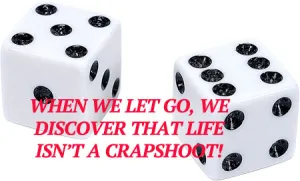Problems?
My dad was an engineer. He loved to take things apart and put them back together. He loved fixing things. When we would break something, he was thrilled. He got a chance to fix something. He often said, “There isn’t anything that can’t be fixed.” I loved those words, but I didn’t like problems. In fact, I hated them.
While he was clearly talking about the material world and stuff, I heard his words on a completely different level. His words fueled my quest to fix my mind and my body, even when others said it wasn’t possible. His words provided a valuable reminder as I took my own mind apart that it could be fixed. I thought I’d have to put my mind back together once I got all the pieces spread all over the floor. But most of the pieces were unnecessary. They weren’t keeping my body running or making my life better. They were just causing problems. These unnecessary mental components weren’t true or necessary for joyful expression; they were simply someone else’s worthless beliefs that were like parasites. They sucked the life out of me while giving nothing in return.
My dad was passionate about fixing things; he used his passion to help us out when needed. But, he didn’t break things just to fix them. If he couldn’t find anything to fix, he used his talents creatively by finding things to build. He enjoyed the bottom of the triangle illusory state of fixing and breaking if the opportunity arose to play there, but he used it in a way that didn’t harm others. He showed me that the illusion can be a sort of playground if we don’t take it seriously or force it on others.
Fixing and Breaking
The bottom of the triangle isn’t bad if used in a win-win way (directed by the True Self). Old buildings must be destroyed before a new one can be erected. Likewise, we destroy our false mind so we can rebuild it. If we know the difference between True and false and creating from First (win-win) and Second (win-lose, good-evil) Cause, we can live outside the suffering that most people consider normal. We avoid creating problems, and we can help others leave their problems behind if they ask for help.
As long as people break things, we’ll need people who fix them. Nevertheless, we must understand how to use our talents properly on the way out of the illusion. On the way into the illusion, we project our beliefs on to others and then fix the effect of our projection in the others. We retain unwanted beliefs, often for financial gain.
I first noticed the power of win-win when I worked in technology. Someone would call me for tech support, and I’d just talk with them. Often I had no clue what their problem was, and I sure as hell didn’t know the answer. But they did. If I talked in the correct general direction, they solved the problem themselves. My clients were all becoming computer experts. They became confident that they could fix their own problems. That made my job really easy. I could focus on creating new ideas and products instead of fixing other people’s problems. We were both happier.
This only works if we can see our creative potential, and if we don’t believe that we need customers for life. I think dentistry is the worst example of second-cause creation. They tell their patients to come in every six months so they can look for the problems that they expect to find so they can fill, drill, and bill. I recently read a study that said people with the best teeth often don’t go to the dentist much. Made sense to me.
Dentists, and other service people, don’t have to walk away from their professions; there’s a proper transition toward freedom. First, they become a dentist that expects to find perfect teeth. They do that by letting go of their knowledge and labels for problems; they recognize that problems come from beliefs and many of those beliefs are perpetuated by them. In accounting, they’d call their expensive dental schooling a sunk cost. It has no future value so you just write it off and move on. They slowly wean their clients off of them and follow their creative inspiration to a better life.
The Lesson
With my dad, we were willing supporters in something that brought him fun. Fixing stuff is clearly part of the illusion, but it was a fun, first-cause part of the illusion for him. We didn’t need to break things to please him. Often he involved us in the fixing process, contributing to our self-sufficiency and confidence that “Anything could be fixed if it happened to break.” His knowledge wasn’t bad because it was directed by his True Self. He still fixes things in his community for a cookie or beer, but only if asked to do so.
The dentist (and most fixers) make knowledge (expertise) more powerful than wisdom (truth). He or she projects problems by believing that they’re true. When I was little, I screamed when taken to the dentist. I noticed they often had ugly or highly repaired teeth. I felt their convoluted energy as they projected their flawed point of view on me. Their beliefs got them bad teeth, and now they wanted me to have them too. That’s second-cause creation; it’s how we perpetuate the illusion.
As we move through the path of initiation, we’re letting go of second-cause creations, beliefs, and memories. They weren’t necessary parts of our mind or our life so we won’t miss them. They were problems that only existed in the illusion — they appeared real but weren’t true. After we trash these unwanted and unneeded components of our mind, we see that they created unnecessary detours and problems in our life. We won’t ever make that mistake again.


